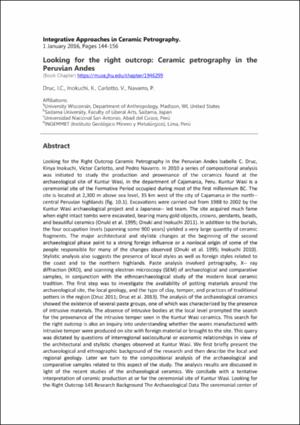Please use this identifier to cite or link to this item:
https://hdl.handle.net/20.500.12544/2476Looking for the right outcrop: Ceramic petrography in the Peruvian Andes
Jan-2016
Integrative Approaches in Ceramic Petrography, 2016, páginas 144-156.
Looking for the Right Outcrop Ceramic Petrography in the Peruvian Andes Isabelle C. Druc, Kinya Inokuchi, Victor Carlotto, and Pedro Navarro. In 2010 a series of compositional analysis was initiated to study the production and provenance of the ceramics found at the archaeological site of Kuntur Wasi, in the department of Cajamarca, Peru. Kuntur Wasi is a ceremonial site of the Formative Period occupied during most of the first millennium BC. The site is located at 2,300 m above sea level, 35 km west of the city of Cajamarca in the north- central Peruvian highlands (fig. 10.1). Excavations were carried out from 1988 to 2002 by the Kuntur Wasi archaeological project and a Japanese- led team. The site acquired much fame when eight intact tombs were excavated, bearing many gold objects, crowns, pendants, beads, and beautiful ceramics (Onuki et al. 1995; Onuki and Inokuchi 2011). In addition to the burials, the four occupation levels (spanning some 900 years) yielded a very large quantity of ceramic fragments. The major architectural and stylistic changes at the beginning of the second archaeological phase point to a strong foreign influence or a nonlocal origin of some of the people responsible for many of the changes observed (Onuki et al. 1995; Inokuchi 2010). Stylistic analysis also suggests the presence of local styles as well as foreign styles related to the coast and to the northern highlands. Paste analysis involved petrography, X- ray diffraction (XRD), and scanning electron microscopy (SEM) of archaeological and comparative samples, in conjunction with the ethnoarchaeological study of the modern local ceramic tradition. The first step was to investigate the availability of potting materials around the archaeological site, the local geology, and the type of clay, temper, and practices of traditional potters in the region (Druc 2011; Druc et al. 2013). The analysis of the archaeological ceramics showed the existence of several paste groups, one of which was characterized by the presence of intrusive materials. The absence of intrusive bodies at the local level prompted the search for the provenance of the intrusive temper seen in the Kuntur Wasi ceramics. This search for the right outcrop is also an inquiry into understanding whether the wares manufactured with intrusive temper were produced on site with foreign material or brought to the site. This query was dictated by questions of interregional sociocultural or economic relationships in view of the architectural and stylistic changes observed at Kuntur Wasi. We first briefly present the archaeological and ethnographic background of the research and then describe the local and regional geology. Later we turn to the compositional analysis of the archaeological and comparative samples related to this aspect of the study. The analysis results are discussed in light of the recent studies of the archaeological ceramics. We conclude with a tentative interpretation of ceramic production at or for the ceremonial site of Kuntur Wasi. Looking for the Right Outcrop 145 Research Background The Archaeological Data The ceremonial center of Kuntur Wasi (fig. 10.2) was occupied during the first millennium BC (Inokuchi 2010). The study of the construction phases, tombs, ceramics, and other cultural materials suggested a local initial occupation period (Idolo phase, 950–800 BC), followed by an important transformation in the ceremonial center and a population input of possible coastal provenance (Kuntur Wasi phase, 800–550 BC). New constructions and expansion of the site mark the third major occupation phase (Copa phase, 550–250 BC), while the last phase is characterized by drastic construction changes and quasi abandonment of the site as a major ceremonial center (Sotera phase, 250–50 BC). Apart from these four phases is the “Sangal complex” within the Kuntur Wasi phase, identified on the basis of a set of ceramics displaying similar stylistic characteristics (Inokuchi 2010; Onuki et al. 1995). In terms of ceramic production, so far no evidence was found suggesting on- site production . But excavations have targeted the ceremon ial area, where ceramic production was probably not taking place. Sixty-one different ceramic stylistic types have been identified (Inokuchi 2010). Several stylistic ceramic types display local characteristics, with a paste matching resources available within a 7–9 km range, as petrographic analysis showed. Albeit fitting chronologically within the stylistic and cultural Chavín Horizon, Kuntur Wasi does not appear to have received direct impact from the ceremonial center of Chavín de Huántar in the north- central Andes (Inokuchi 1998). Rather, stylistic analysis suggests influences...
University of Utah Press
Druc, I.C.; Inokuchi, K.; Carlotto, V. & Navarro, P. (2016). Looking for the right outcrop: Ceramic petrography in the Peruvian Andes. En: Ownby, M.; Druc, I.& Masuci,M.,eds. Integrative Approaches in Ceramic Petrography. Utah: University of Utah Press, p.144-156.
Páginas 144-156.
Files in This Item:
| File | Description | Size | Format | |
|---|---|---|---|---|
| Druc-Looking for_the_right_outcrop.pdf | Abstract | 72.92 kB | Adobe PDF | View/Open |
This item is licensed under a Creative Commons License












